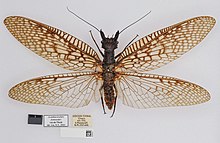Acanthacorydalis fruhstorferi
| Acanthacorydalis fruhstorferi | |
|---|---|

| |
| Female | |
| Scientific classification | |
| Domain: | Eukaryota |
| Kingdom: | Animalia |
| Phylum: | Arthropoda |
| Class: | Insecta |
| Order: | Megaloptera |
| Family: | Corydalidae |
| Genus: | Acanthacorydalis |
| Species: | A. fruhstorferi |
| Binomial name | |
| Acanthacorydalis fruhstorferi van der Weele, 1907 | |
Acanthacorydalis fruhstorferi is a species of dobsonfly native to Vietnam and China. It holds the title of largest aquatic insect by wingspan according to the Guinness Book of World Records at 21.6 cm.[1][2] The title formerly belonged to the Brazilian damselfly Microstigma rotundatum.
Acanthacorydalis fruhstorferi was first described by Herman Willem van der Weele in 1907 from a specimen from "Than-Moi" (probably in Lạng Sơn Province[3]), Vietnam. It is found throughout Southern China (Fujian, Guangxi, Guangdong, Guizhou, Jiangxi, Yunnan, and Zhejiang) and Northern Vietnam.[4]
Liu and associates proposed in 2005 that the species is most closely related to Acanthacorydalis sinensis citing morphological similarities relative to similar Chinese genera of Acanthacorydalis. Specifically the wing and body colouration, yet differed by A.sinensis's lack of sagittal dorsal division.[4]
Life history
Eggs are deposited between stones near flowing water.
Larvae inhabit streams or rivers with low contamination. Larvae are sensitive to pH changes, with instances of A. fruhstorferi populations being reduced due to developments in urbanized locations such as Panzhihua, Sichuan. Typical of other dobsonflies, A. fruhstorferi larvae prey on aquatic insects, juvenile amphibians and small fish.
Adults display strong phototaxis and are often seen near waterside lamps. Adult A. fruhstorferi are not predatory, and instead feed on tree sap.[5]
A. fruhstorferi individuals display sexual dimorphism. With both body and weapon size being different between sexes. Head size is not different between individuals of differing sexes, and nuptial gifts are smaller relative to other dobsonflies.[6]
Etymology
The genus name Acanthacorydalis is a combination of the Greek Ἀκάνθα (acantha, thorny) with κορυδαλλις (corydalus, pertaining to κορυς, the crest of a helmet). In this specific instance, κορυδαλλις alludes to the genus Corydalus found in North America, for whom it shares the same family with.
The specific epithet fruhstorferi pertains to 19th century entomologist Hans Fruhstorfer.
See also
References
- ^ "Largest aquatic insect (by wingspan)". Guinness World Records. 12 July 2015. Retrieved 13 February 2020.
- ^ "China receives second Guinness World Record for large insects". chinaplus.cri.cn. Retrieved 8 May 2020.
The IMWC also has the world's largest aquatic insect, a dobsonfly (Acanthacorydalis fruhstorferi) with a wingspan of 21.6 cm.
- ^ French Government archive (retrieved 22 September 2021)
- ^ a b Liu, Xing Yue; Yang, Ding; Ge, Si Qin; Yang, Xing Ke. "Phylogenetic review of the Chinese species of Acanthacorydalis (Megaloptera, Corydalidae)". Retrieved 13 February 2020.
- ^ "The Behemoth of the Microcosm: Acanthacorydalis fruhstorferi - Insect Museum of West China". Google Arts & Culture. Retrieved 13 February 2020.
- ^ Liu, Xingyue; Hayashi, Fumio; Lavine, Laura C.; Yang, Ding (22 May 2015). "Is diversification in male reproductive traits driven by evolutionary trade-offs between weapons and nuptial gifts?". Proceedings of the Royal Society B: Biological Sciences. 282 (1807): 20150247. doi:10.1098/rspb.2015.0247. PMC 4424648. PMID 25925103.
